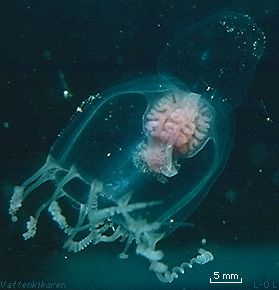|

Distribution in scandinavian waters
|
Maximum height: 4 ,5 cm.
Appearance: The mouth is situated at the top of the tubular formationen
that hangs from the middle of the "umbrella´s" underside. Along
the inside edge is a peripheral crease, and the tantacles hang from
the outer edge of the "umbrella". The anthomedusae tentacles are few,
and the "umbrella" form is relatively high. The organs that produce
eggs and sperms are placed by the mouth or on the stomach. The anthomedusae
are usually transparent, although the nether parts of the mouth and
the thicker areas of the tentacles are distinctly pigmented - black,
brown, blue, red, yellow, green or other colour tones.
Compare the anthomedusae with the leptomedusae
and other jellyfish.
Depth: Sea-level to unknown depth.
Environment: Pelagic.
Misc: The anthomedusae catches and eats small organisms and suspended
remains from the surrounding water. These medusae do not sting enough
to cause discomfort to people. Representatives of the anthomedusae group
are found globally. The medusae stage is part of a life
cycle that is similar to the leptomedusae.
Classification: The specimen in the picture above is probably
of the species Neoturris pileata. Anthomedusae are part of the
hydroid group
under the cnidarians.
|


